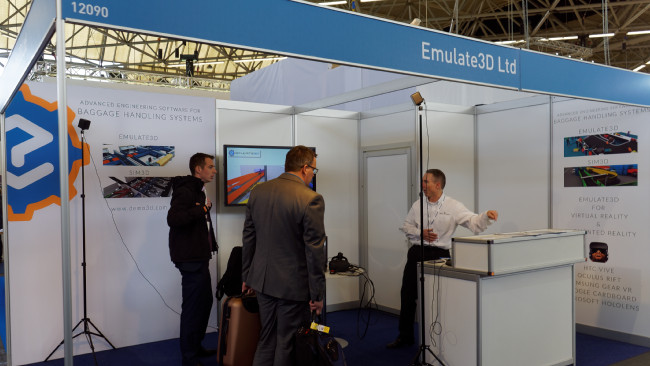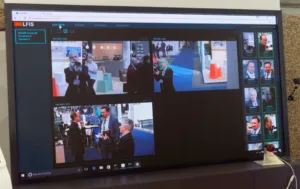The Passenger Terminal Expo is something of a marginal event for us. Although there are some display-related stories, usually there is not much so whether we attend depends on how we can fit it in with other things. The show this year was at the RAI (the last couple of years it has been in London and Cologne) which is convenient and cheap and easy to get to, so we went along. The main news story from our point of view was the first appearance of a dedicated stand showing displays from LG Electronics, which is following in the path set by others, into B2B. The stories that we found split neatly between the mobile and large categories, so we have split our coverage between the two newsletters.
As a regular traveller that spends a lot of time in airports, it is interesting to see the trends in areas such as security. This year, what impressed me was the development of tracking technologies. Using the tracking of bluetooth or Wi-fi devices (by their mac id) to monitor the movement of people around retail environments or airports is not new. What was new this year was the number of companies that had technology that can use facial recognition fast enough to use that technology to track individuals, so capturing even those that do not have electronic devices. The systems are fast enough to track relatively large crowds. In terms of concern about ‘Big brother’, this must be an issue.
Facial recognition is getting ‘spookily’ good. Image:Meko
On the positive side, a number of companies had passport/facial recognition systems that worked fast enough to allow travellers to simply walk through gates to get security or passport clearance. That would be nice! There were also scanners that could check for dangerous items without the unpacking and shoe/belt removal that slows down security. There’s hope for a less stressed passage through airports!
 Passenger processing is using facial recognition and this system is being developed by Vision-Box with Schiphol. Image:Meko
Passenger processing is using facial recognition and this system is being developed by Vision-Box with Schiphol. Image:Meko
Of course, airlines will still want you at the gate early, as the loading systems are so inefficient. (There has been research to show ways of loading planes that would be much faster, for example, starting with window seats in alternate rows, then filling in from the edges and back. However, frequent flyers like to get on first and take the front seats, so that isn’t popular. Couples also like to board together. My own view is that planes should be like the tractors of trucks, they should hold ‘containers of people’. Swivel the nose away and slide in a tube full of passengers, which can then be loaded and unloaded without the plane needing to hang around!). Airport operators see the speeding up in the administration as a chance for travellers to spend more money.
Our friends at NEC told us that the airport operators also see that arrivals are an area that could be developed. At the moment, those waiting for arriving travellers spend a lot of time, but not that much money. If those waiting had better information about when the plane is landed, or passengers in immigration or waiting for baggage, then they could use the time to have a coffee or do some shopping. That is good for the airports. There are also opportunities to use social media – for example by showing tweets and selfies from arriving customers or waiting friends and family.
NEC, which is a leader in the suppliers of airport displays, also told us that the airport business globally is incredibly busy and lively at the moment. There are, apparently 140 new airports being built around the world, which means a lively market.
At the show, a number of companies were using VR on their booths to show, for example, baggage handling equipment, allowing delegates to have a look around installations and equipment, without the need for bringing the equipment to the show.
 VR was being used to show installations and equipment to prospective customers. Image:Meko
VR was being used to show installations and equipment to prospective customers. Image:Meko
Another item that caught my attention, although nothing to do with displays was a ‘robot’ valet parking system that can automatically pick up (lifting the car slightly off the ground) a car from a special area and put it in a car park without needing a driver to get into the car. Because the doors don’t need to be opened, cars can be parked very close together and the company selling the system claimed that 50% more cars could be parked in a particular area. This is very cool, and clearly something that we’re going to see as the operator also saves the cost of the space and the drivers. Further, the car owner doesn’t have to leave their keys and knows that there will be nobody entering the car.
The show was busy and lively, with the investment going in making the feeling very positive. However, it remains quite a small event. As we went to press, the organisers said that there were 6,800 delegates over the first two days, a record attendance. The show will be in Stockholm for the next couple of years. That will make it harder for us to justify in time and cost, sadly. If you value our coverage, please let us know!
PTE 2018 will be in Stockholm from 20th to the 22nd of March and in 2019 from 19th to the 21st of March.

